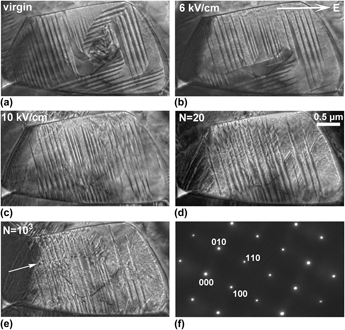Article contents
In situ TEM study on the microstructural evolution during electric fatigue in 0.7Pb(Mg1/3Nb2/3)O3–0.3PbTiO3 ceramic
Published online by Cambridge University Press: 28 August 2014
Abstract

In this work, we report an experimental technique with nanometer resolution to reveal the microstructural mechanism for electric fatigue in ferroelectrics. The electric field in situ transmission electron microscopy (TEM) was used to directly visualize the domain evolution during the fatigue process in a 0.7Pb(Mg1/3Nb2/3)O3–0.3PbTiO3 ceramic. The structure–property relationship was well demonstrated by combining the microscopic observations with corresponding dielectric, piezoelectric, and ferroelectric properties measured on bulk specimens. It was found that the domain switching capability was substantially suppressed after 103 cycles of bipolar fields, leading to an immobilized domain configuration thereafter. Correspondingly, a pronounced degradation of the functionality of the ceramic was manifested, accompanying with a coercive field bumping and polarization current density peak broadening. The reduction of the polarization, dielectric constant, and piezoelectric coefficient were found to follow a power-law relation. Seed inhibition mechanism was suggested to be responsible for the observed fatigue behaviors.
- Type
- Articles
- Information
- Journal of Materials Research , Volume 30 , Issue 3: Focus Issue: In-situ and Operando Characterization of Materials , 14 February 2015 , pp. 364 - 372
- Copyright
- Copyright © Materials Research Society 2014
References
REFERENCES
- 10
- Cited by




